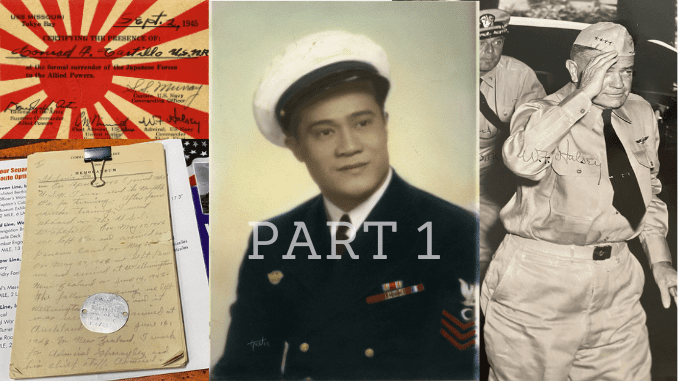
The Jefferson Barracks National Cemetery is an American military cemetery located in St. Louis County, Missouri, just on the banks of the Mississippi River. Within the 237 000 interments there are seven Medal of Honour recipients and numerous other notable individuals.
In Section K Site 585 there is a head stone that reads “ADMIRALS BOY” at the bottom – the inscription belongs to WW2 veteran ST1 Conrad F. Castillo of the US Navy.
Today a reference to “Amirals Boy” might be seen derogatory, to a US Navy veteran, particularly one of WW2, it will mean something different. To Conrad Castillo it held such a profound meaning that it is today inscribed on his head stone.
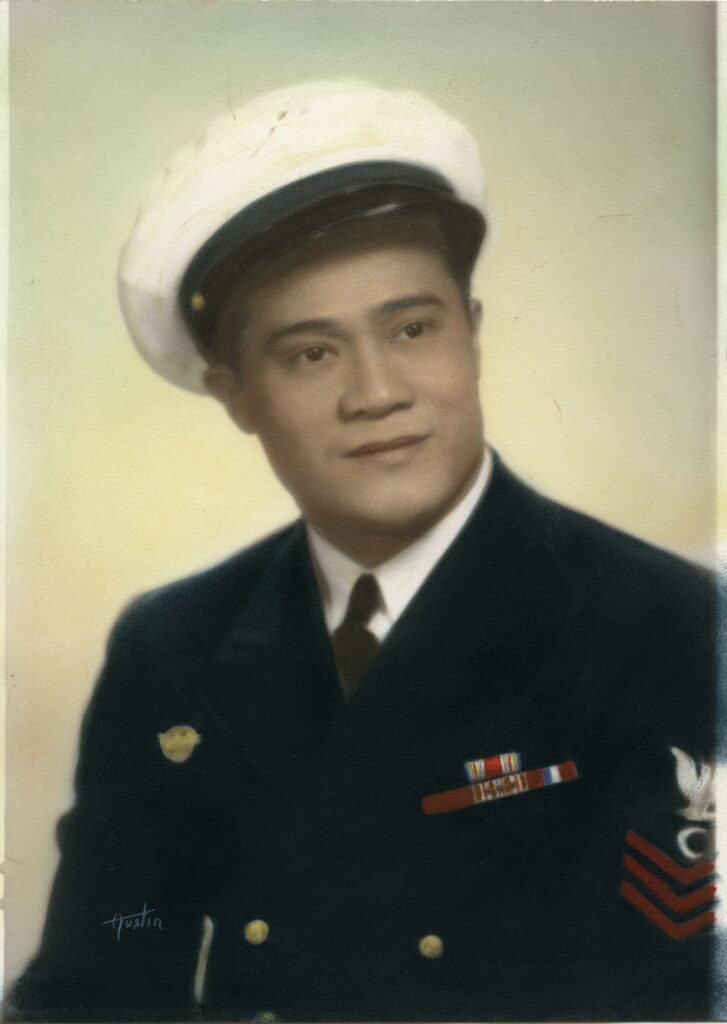
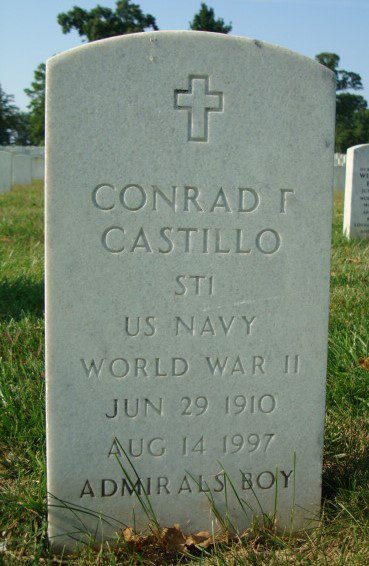
Images from Castillo collection courtesy of Jeff Mossinghof.
The Admiral in question is none other than Fleet Admiral William F. Halsey Jr. Thanks to Castillo’s grandson, Jeff Mossinghof, we are given a rare opportunity to peak into his grandfathers’ incredible story that placed him at the epicentre of some of the most pivotal and decisive moments of the Pacific War.
With other original documents in extraordinary good condition, kept within the family, we can follow the footsteps and illuminate a very small part of the service that made him want to be remembered as the ‘Admirals Boy’.
The Journal
The 47-page journal is entirely handwritten on loose memorandum pages marked “COMMANDER THIRD FLEET”. After transcribing the entries research added context and detail to the events scarcely described by Castillo. While obtaining this deeper understanding a clearer picture emerged suggesting that the journal has two parts.
Entries made prior to 12 September 1944 appear to be backdated recollections of past events. Several of the entries do not come in chronological order as history recorded them, but rather in the order that Castillo recalls them while writing them down.
With the entry made for 12-13 September 1944 and onwards, all further entries come in chronological order. Castillo put to sea with Adm. Halsey on the USS New Jersey (BB-62) on 24 August 1944. It is possible that settling in with the routine of being at sea he found time to start the journal.
Unfortunately, Castillo only keeps this journal going while stationed on USS New Jersey. It ends with mention of arriving Ulithi on the 25th and leaving on 27th January, 1945 arriving at Pearl Harbor on 6 February…to then ultimately end the journal with stating to have a 30 day leave on main land with upcoming second operation aboard USS Missouri.
The below image is taken, of the journal with one of Castillo’s dog tags on top, onboard the USS New Jersey BB-62 on 4 July 2022 by Jeff Mossinghof when he toured the ship. Picture taken in what possibly was his grandfather’s berthing area on the ship during her WWII configuration.
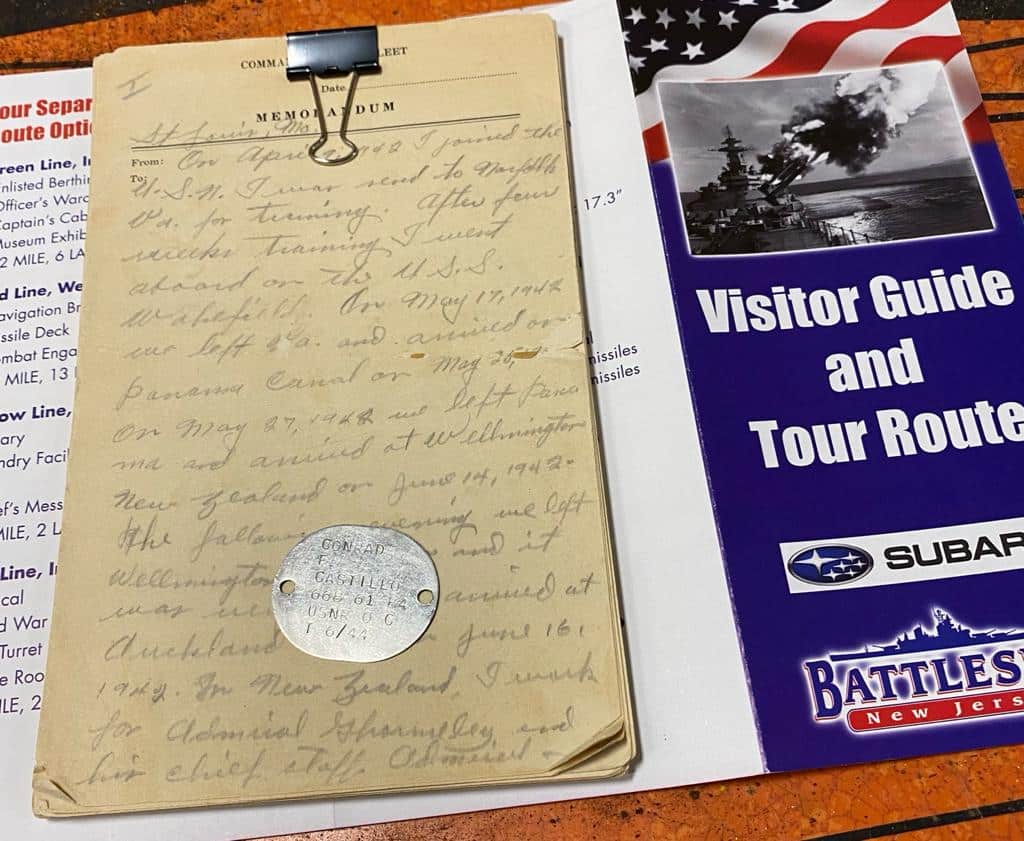
Image courtesy of Jeff Mossinghof
Early life and immigration to US – 1928
Castillo was born in Paoya, Ilocos Norte of the Philippines on 29 June 1910. From what can be gathered he has 2 brothers; the older Francisco (Frank) and younger Alfredo (Freddie) as well as a younger sister Lapaz.
By the age of eighteen he is a working man as per the revenue card where he ‘voluntarily’ pays 2 Pesos on 18 May 1928 to an Internal Revenue Officer. The card is given the formal stamp of Juan Posadas, Jr who was then a Collector of Internal Revenue in the Manila area but would later between 1934 and 1940 serve as Mayor of Manila.
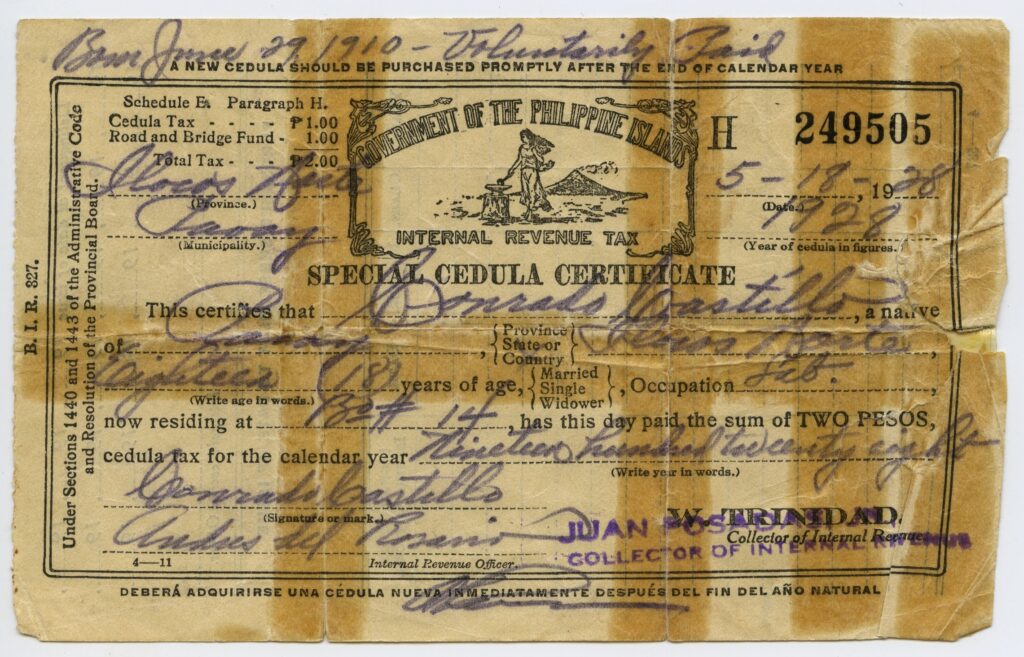
Image from the Castillo collection courtesy of Jeff Mossinghof.
In less than a month from this document being issued Castillo would leave Manila for USA.
Conrad Castillo arrives to San Francisco with on 11 July 1928 with a ship that departed Manila on 16 June. His younger brother Alfredo (Freddie) will come to US the following year on SS Shinyo Maru on 29 May 1929 while his older brother Francisco (Frank) arrived to Honolulu later 26 September the same year with the SS President Jackson.
Spearheading the brothers move to US Castillo’s own journey was made on SS President Pierce, previously known as Hawkeye State. The ship would in July 1941 become USS Hugh L Grant (AP-43) when delivered to the War Department. Taking part in the allied invasion of French North Africa, Operation Torch, she was torpedoed and sunk 12 November 1942 during the Naval Battle of Casablanca.
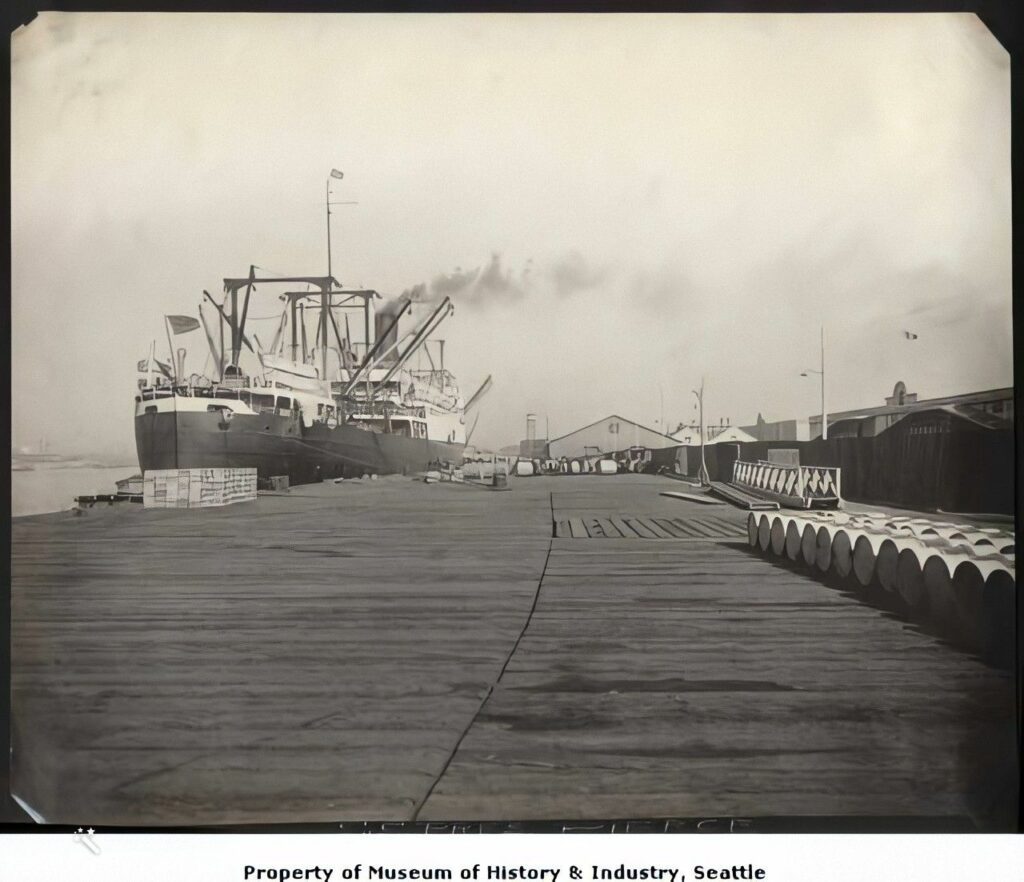
A.F. Haines Photograph Album, Museum of History & Industry, Seattle; All Rights Reserved
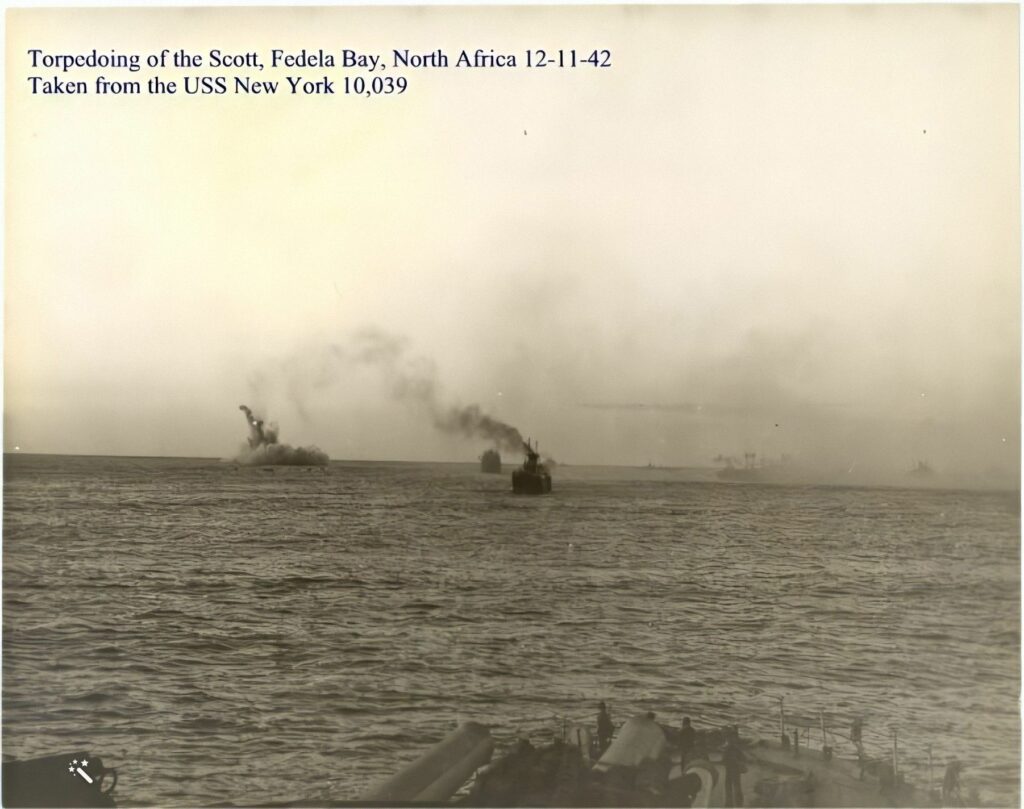
US Navy photo # BUAIR NWYK 10,039
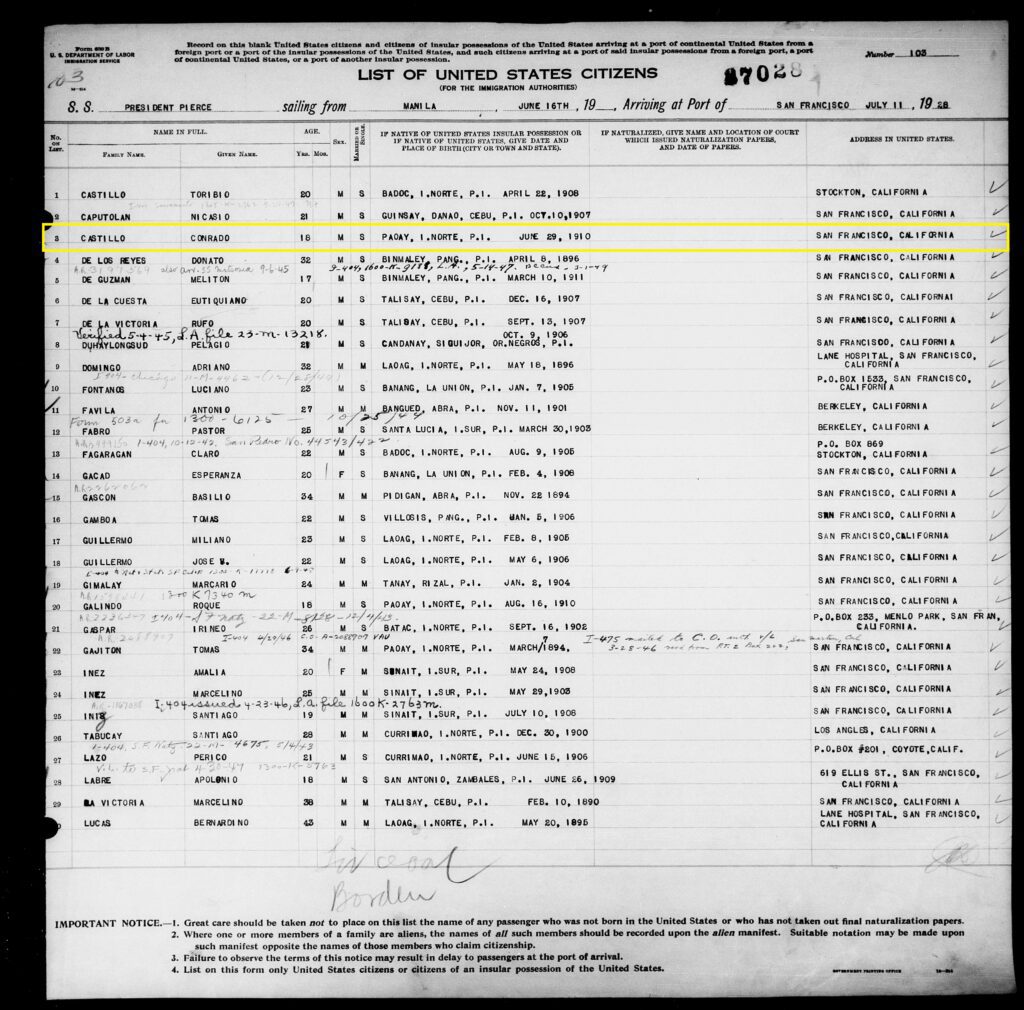
Montezuma Mountain School for Boys – 1930
In scrap book photographs shared by Jeff Mossinghof his grandfather is seen posing by a sign saying, “Montezuma Mountain School for boys”. The pictures are undated but clearly shows a young Castillo posing with the Montezuma School sign.
The Montezuma Mountain School for Boys was in operation between 1910 and 1955 as a private residential school for boys in first grade through high school. Youngsters came from throughout the country and abroad to learn from Professor Ernest Rogers, an educational pioneer who ran the school and infused it with his avant-garde theories [1]https://www.mercurynews.com/2013/03/18/from-the-archives-montezuma-mountain-school-for-boys-a-rustic-campus-for-children-of-privilege/.
Described as a school with a rustic campus for children of privilege Castillo and his two brothers hold employment here. In the 1930 Census for the institution “Montezuma Mt. Ranch School” conducted by Enumerator Ella Lindsay, on 11 April 1930, Castillo is listed as a janitor. His two brothers, Alfredo (Freddie) and Francisco (Frank) are listed as Dining Room Boys.
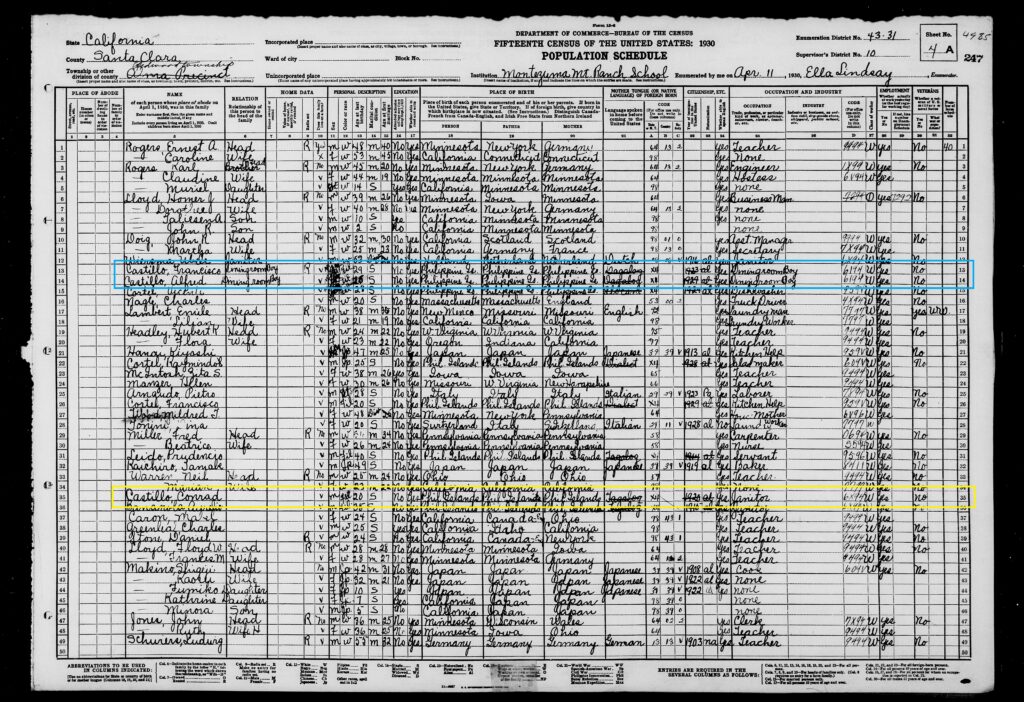
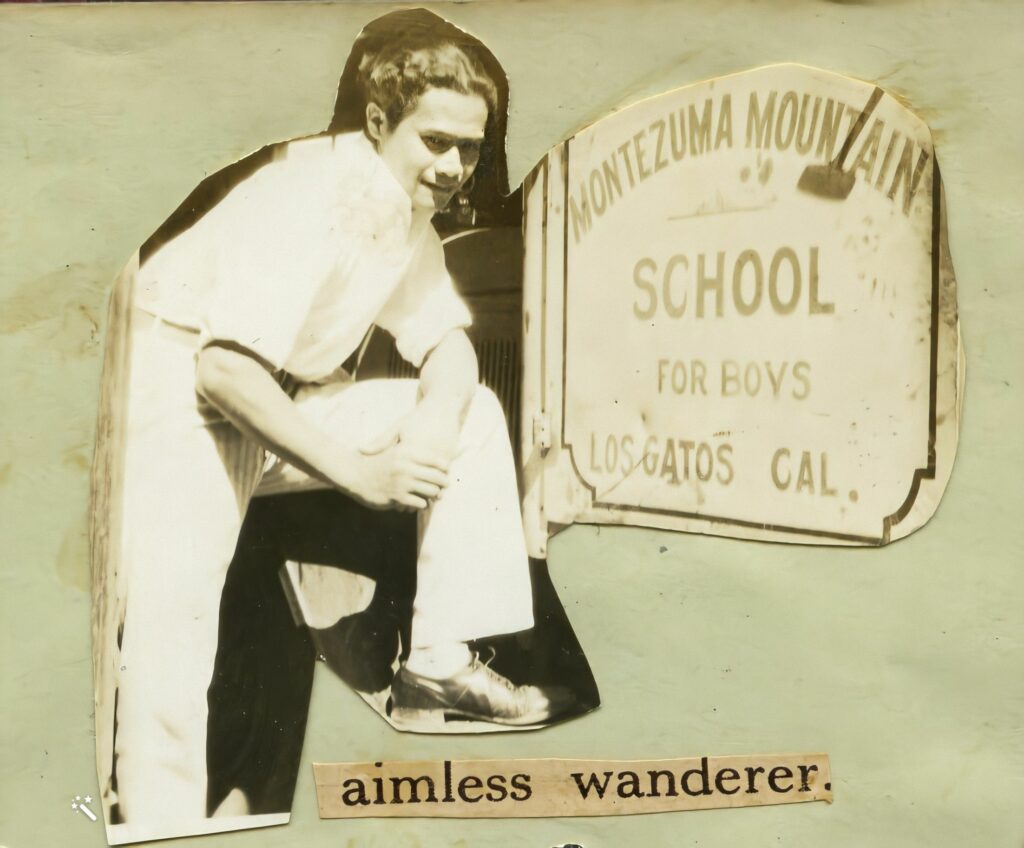
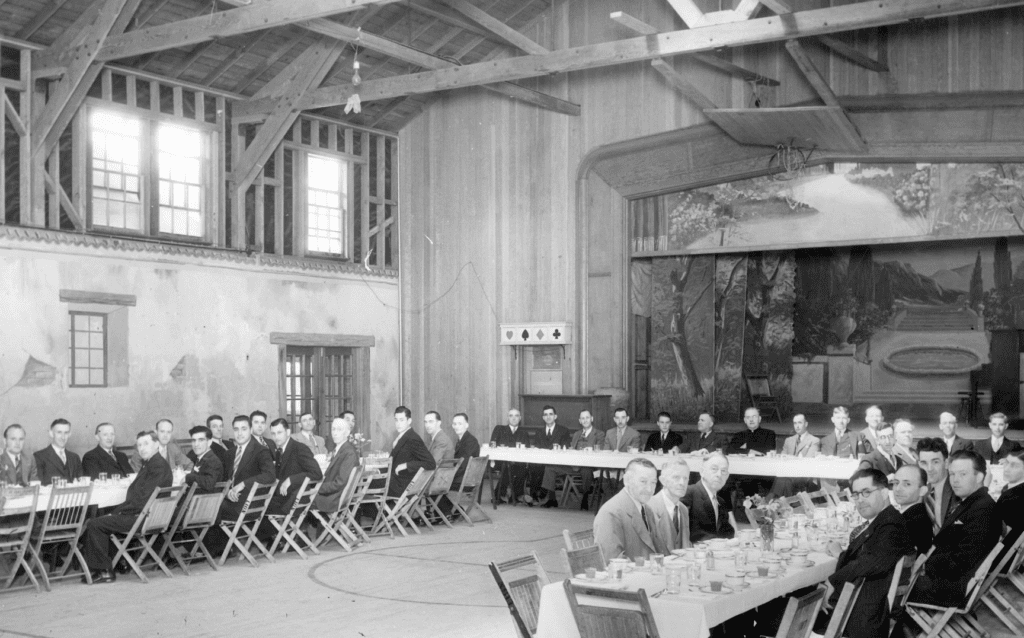
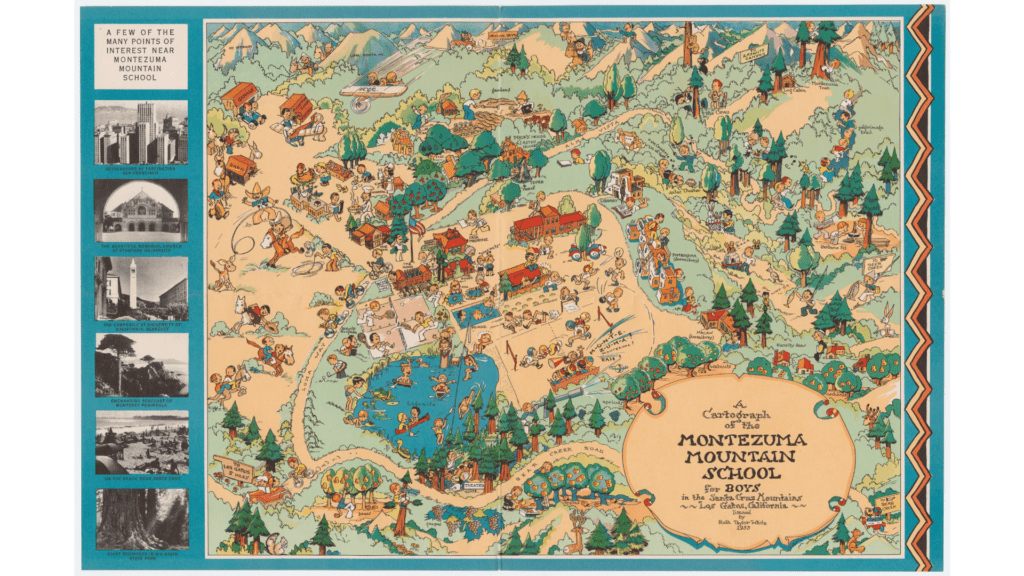
Drafted and Pig ‘N Whistle – 1940
On September 16, 1940, the United States instituted the Selective Training and Service Act of 1940, which required all men between the ages of 21 and 45 to register for the draft. This was the first peacetime conscription in United States history.
With thousands of other men Castillo will register for the draft and on 16 October 1940 he completes the DSS Form 1 as a resident of 411 E 4th Street, Los Angeles in California.
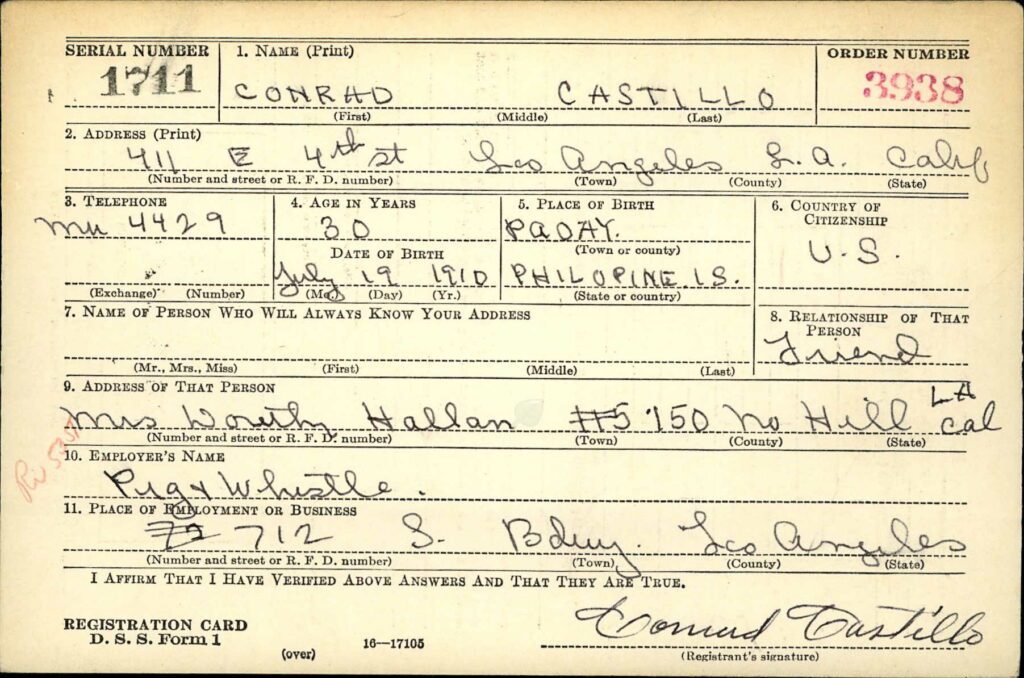
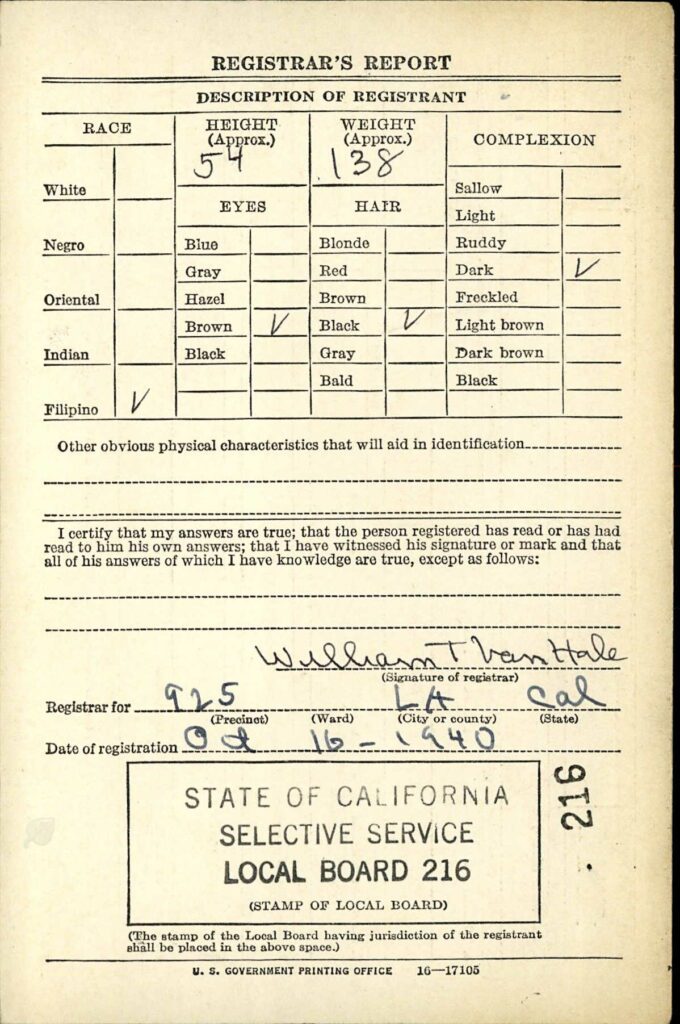
At this time the three Castillo brothers appear to have ended their employment and moved from the Montezuma Mountain Ranch School. Brothers Frank and Freddie both register in St Louis, Missouri while Conrad evidently does so in Los Angeles, California.
He states to hold employment at the “Pig’N Whistle” located on 712 S. Broadway, Los Angeles. The Pig ‘n Whistle was founded in 1908 and became a chain of restaurants that were casual but also considered refined and somewhat elegant. The menus were elaborate even though prices were moderate. [4]https://restaurant-ingthroughhistory.com/2011/05/26/famous-in-its-day-pign-whistle/
Chase Hotel, St. Louis – early 1940’s
Castillo’s grandson Jeff recently reached out and contacted descendants of his grandfather’s brothers. It becomes very apparent how the brothers keep close to each other through life as Castillo later follows his two brothers and settle in St. Louis.
Here he held employment at the Chase Hotel up to his enlistment in 1942. He works as a waiter in the Zodiac Cocktail Lounge which opened in December 1940 replacing the open-air Roof Garden. The glass enclosed room had a blue neon “CHASE” sign installed atop the Zodiac Lounge’s circular orchestra bay. The hotel and glass-enclosed room still exist today.[5]http://www.losttables.com/chase/chase.htm
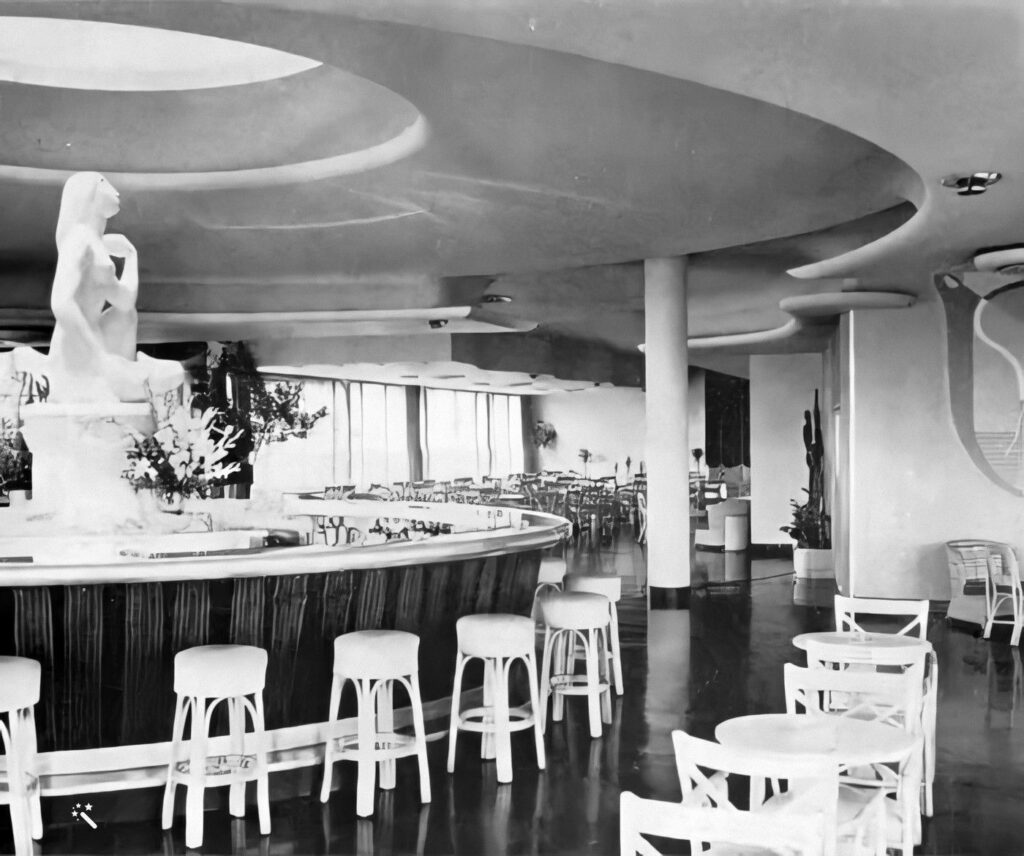
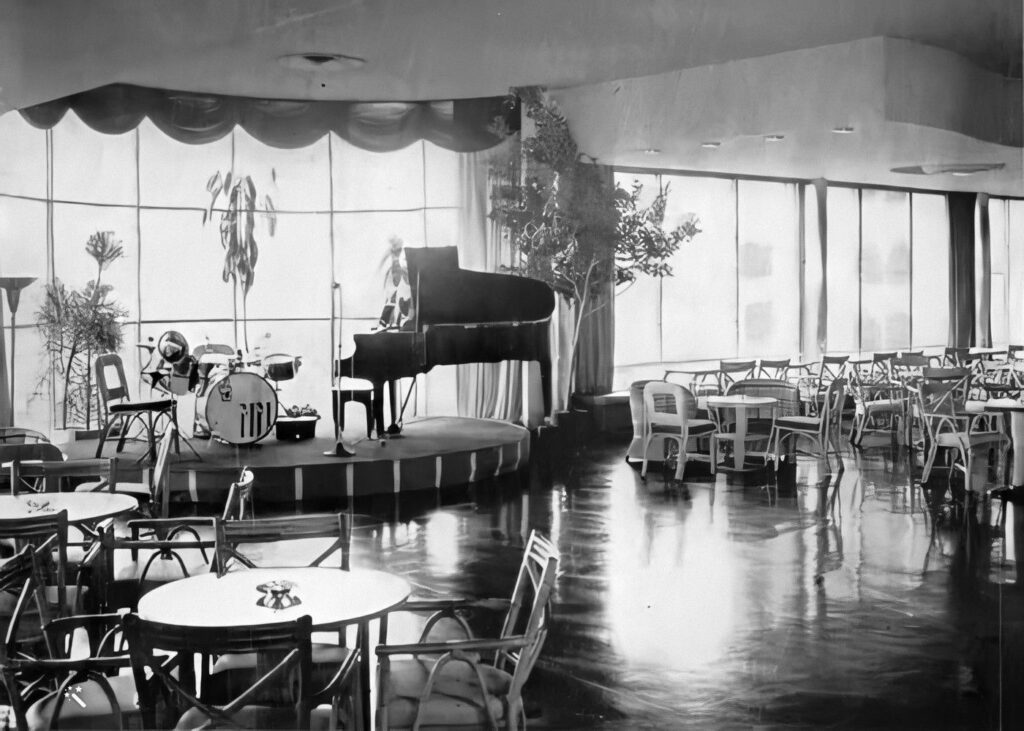

http://www.losttables.com/chase/chase.htm
Enlisting & the Messman/Steward Branch – April 1942
Conrad Castillo enlists with U.S. Navy and is issued a Recruit Identification Card on 9 April 1942 in St. Louis, Missouri. These cards, as one might expect, served to identify sailors often basing their identification upon their physical characteristics. In addition to height, weight, hair, and eye colour Castillo’s “Prominent marks” include burn scars on his “lower thor.”.
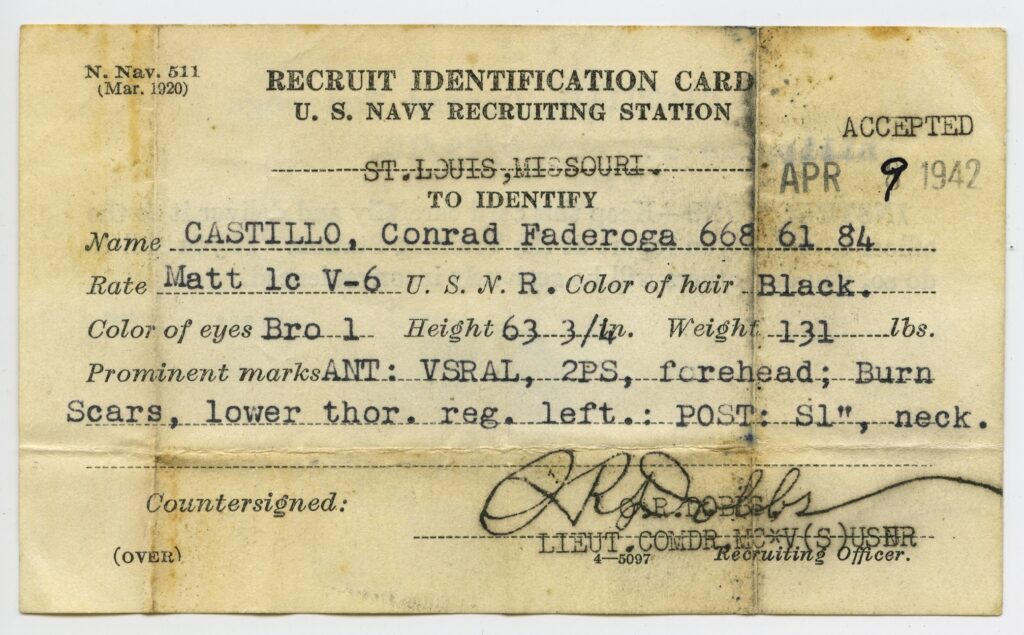
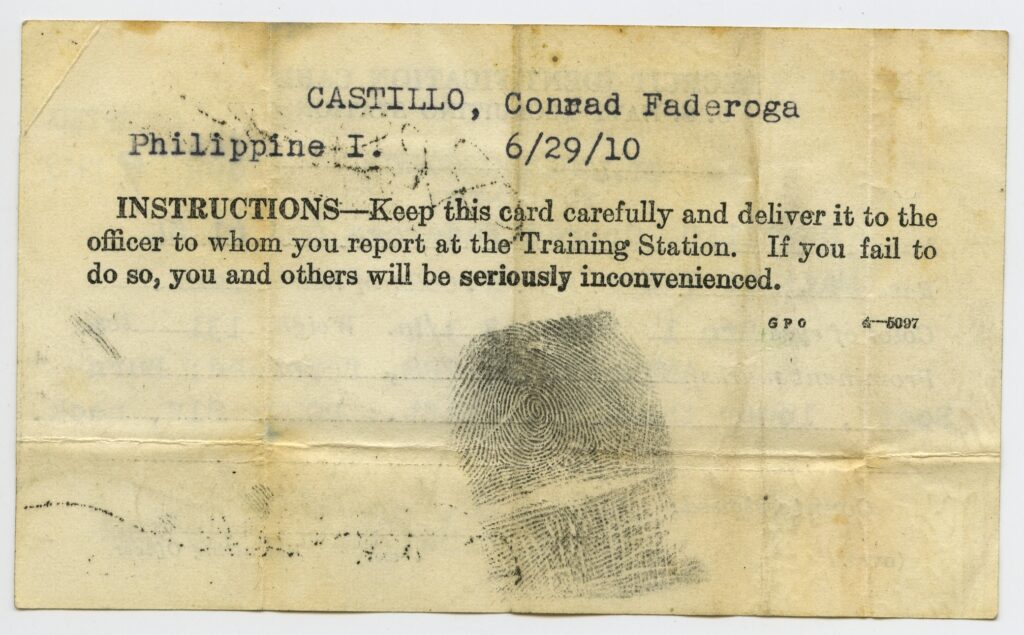
He is sent to the Navy Mess Attendant School in Norfolk, Virginia. In this racially segregated part of U.S. Navy recruits of African descent and their counterparts of Asian-Pacific heritage attended this school receiving training to assume duties of feeding and serving officers.
The Messman Branch was not to be confused with the Commissary Branch which was responsible for provisioning and preparing food for the Navy’s enlisted personnel.[6]https://uniform-reference.net/insignia/usn/usn_ww2_enl_steward.html Conrad’s younger brother Freddie also enlisted and served through the war in the Commisasary Branch as a COOK1.
White sailors could not serve in the Messman Branch, this attracted criticism from civil rights leaders during the war, and the Roosevelt administration was under some pressure to address this inequality. Some steps were taken throughout the war, but the navy’s leadership proved resistant to major change. In February 1943 the name of the branch was changed to Steward Branch, the word “officer’s” was dropped from rate titles, and “mess attendant” became “steward’s mate.”[7]https://uniform-reference.net/insignia/usn/usn_ww2_enl_steward.html
More than 1100 members of the Messman/Steward Branch were killed during WW2. Some fellow Norfolk trainees decorated for heroism include Navy Cross recipients Doris Miller, William Pinckney and Leonard Harmon.[8]https://www.hmdb.org/m.asp?m=70260
Castillo is sent to Norfolk with the rank of Matt 1c (Mess Attendant 1st Class). Here he would most likely have received his training in the barracks at Unit “K-West”.
The two below images are taken outside these barracks in Norfolk. Castillo, in the dark uniform, is wearing the rank of Matt 1c on his sleeves. The gentleman to his left is his brother Alfredo “Freddie” Castillo who went on to serve on USS Essex (CV-9).
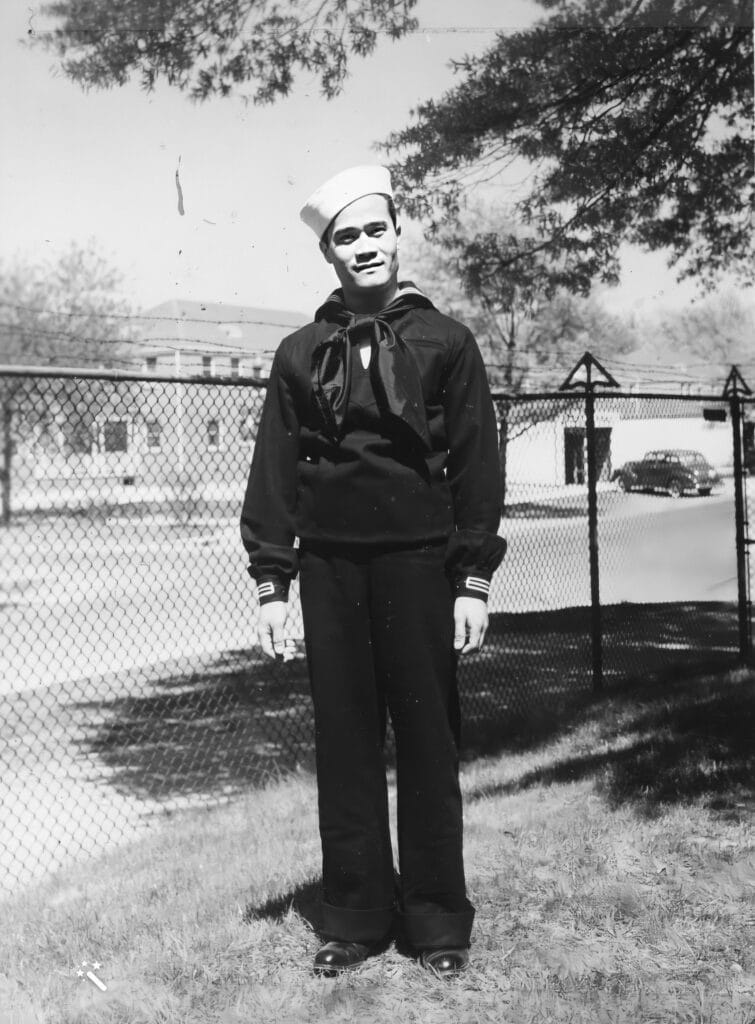
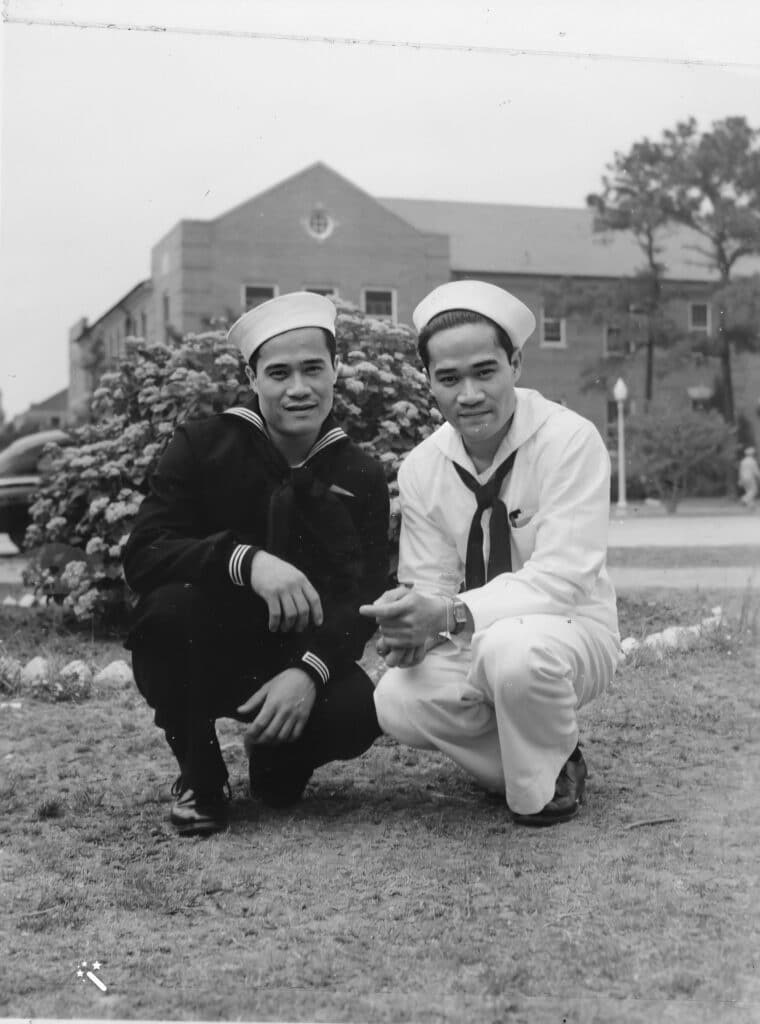
In Norfolk he receives 4 weeks of training before shipping out to the Pacific on the USS Wakefield (AP-21). He boards the ship on 17 May 1942 in Norfolk, Virginia with other Marine, Navy and Army passengers.
The over 4000 Marines on board turns out to be a 1st Echelon of the 1st Marine Division, 5th Marines who would soon launch Operation Watchtower by invading Guadalcanal.[9]https://nzshipmarine.com/nodes/view/27
The USS Wakefield departs anchorage in Hampton Roads at 0530 on 20 May 1942 as part of Task Force 32[10]USS WAKEFIELD – War Diary, 5/1-31/42. Conrad F. Castillo embarks on a 3 years and 8 months long remarkable journey that will put him in the epicentre of some of the pivotal moments of the Pacific war.
For all parts in the Castillo series please see below:
- Conrad F Castillo – Part 1 – Beginnings
- Conrad F Castillo – Part 2 – New Zeeland
- Conrad F Castillo – Part 3 – Noumea
- Conrad F Castillo – Part 4 – USS New Jersey BB62
- Conrad F Castillo – Part 5 – Mog Mog, Kamikazes and Typhoons
References


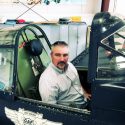
Be the first to comment